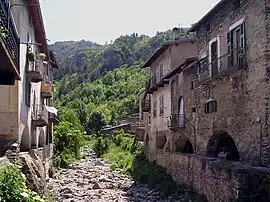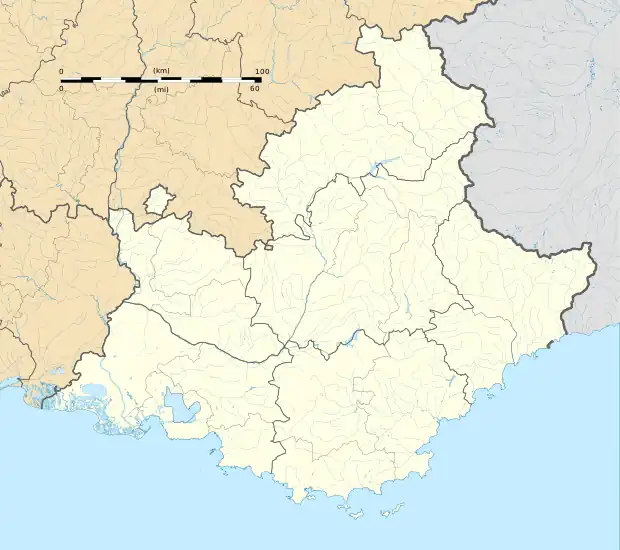La Brigue | |
|---|---|
 A view of the dry riverbed of the Rio Sec in La Brigue | |
.svg.png.webp) Coat of arms | |
Location of La Brigue | |
 La Brigue  La Brigue | |
| Coordinates: 44°03′47″N 7°37′01″E / 44.0631°N 7.6169°E | |
| Country | France |
| Region | Provence-Alpes-Côte d'Azur |
| Department | Alpes-Maritimes |
| Arrondissement | Nice |
| Canton | Contes |
| Intercommunality | CA Riviera Française |
| Government | |
| • Mayor (2020–2026) | Daniel Alberti[1] |
| Area 1 | 91.77 km2 (35.43 sq mi) |
| Population | 719 |
| • Density | 7.8/km2 (20/sq mi) |
| Demonym | Brigasques |
| Time zone | UTC+01:00 (CET) |
| • Summer (DST) | UTC+02:00 (CEST) |
| INSEE/Postal code | 06162 /06430 |
| Elevation | 559–2,650 m (1,834–8,694 ft) (avg. 812 m or 2,664 ft) |
| 1 French Land Register data, which excludes lakes, ponds, glaciers > 1 km2 (0.386 sq mi or 247 acres) and river estuaries. | |
La Brigue (French pronunciation: [la bʁiɡ]; Ligurian: Briga; Occitan: La Briga; Italian: Briga Marittima) is a commune in the Alpes-Maritimes department in southeastern France.
La Brigue became part of France after World War II, when Italy was forced to hand it over in September 1947 under the terms of the Peace of Paris. Before the hand over, it was part of the Province of Cuneo and was officially known as Briga Marittima. The transfer, which was not unopposed in the village, was retrospectively endorsed by a local plebiscite which took place on 12 October 1947 and was subject to international supervision.
History
After World War II, France asked for the annexation of the territories of Tende and Brig, and obtained them according to the provisions of the Treaty of Paris signed on 10 February 1947, which entered into force on the following 15 September.
However, due to the fact that the Constitution of the French Fourth Republic required that there be no territorial acquisitions without the consent of the populations concerned, the French authorities held a referendum with the population on 12 October, so that they could choose between France and Italy, even though La Brigue was already under the military and administrative control of France since the entry into force of the peace treaty in September.
The prospect of a change of nationality divided the socialist family, in any case a minority in La Brigue. On the one hand, the Italian Socialist Party was in favor of annexation, while on the other, paradoxically, the charismatic leader of the French socialists Leon Blum was the most critical of this expansionist project. Either way, in the 1947 plebiscite on the issue, the Brigasks chose in favor of the transfer of sovereignty. Only citizens who resided in the area at the time of the referendum, with at least one parent born in the countries concerned or who could prove that they were domiciled there before the seizure of power by the fascists in Italy in 1922 were admitted for the vote. Part of the inhabitants who had taken refuge in Italy were thus excluded from the vote, since they had not changed their nationality to acquire French nationality. The result gave an almost unanimous support (96.07%) for France: out of 790 voters, 759 chose France and 26 Italy. There were five blank or unvalid ballots. When the data from the 1946 Constituent vote was compared with those from 1947 for the Treaty, it was concluded that the exiles would not have been able to reverse the outcome of the second vote. The outcome of this plebiscite was consistent with that of 1860 at the end of which the County of Nice had become French.
Sights
Looking across the village to the northwest, high rocky cliffs tower over La Brigue.Many of the buildings are of natural stone and many are nicely renovated with pastel facades and green lauze doorways and steps. The Shrine of Our Lady of the Fountains is the home to a huge 15th-century painting (cycle of passion) by the painter Giovanni Piemontese Canavesio, and is a major tourist destination.
Tourism
The village is situated along the long-distance hiking trail GR52A.[3] Another attraction for mountain sports enthusiasts is a nearby via ferrata of medium difficulty (C/D)[4] which ascends about 250 metres above the village.[5]
Demographics
| Year | Pop. | ±% p.a. |
|---|---|---|
| 1968 | 582 | — |
| 1975 | 493 | −2.34% |
| 1982 | 495 | +0.06% |
| 1990 | 618 | +2.81% |
| 1999 | 595 | −0.42% |
| 2009 | 665 | +1.12% |
| 2014 | 713 | +1.40% |
| 2020 | 696 | −0.40% |
| Source: INSEE[6] | ||
Twin towns — sister cities
La Brigue is twinned with:
 Triora, Italy (2006)
Triora, Italy (2006)
See also
References
- ↑ "Répertoire national des élus: les maires" (in French). data.gouv.fr, Plateforme ouverte des données publiques françaises. 4 May 2022.
- ↑ "Populations légales 2021". The National Institute of Statistics and Economic Studies. 28 December 2023.
- ↑ "GR 52A".
- ↑ German Via-Ferrata Database: http://www.klettersteig.de/klettersteig/via_ferrata_de_la_ciappea/1013
- ↑ Via Ferrata of La Brigue: http://www.labrigue.fr/index.php?id=4563
- ↑ Population en historique depuis 1968, INSEE